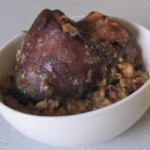Soul food is a variety of cuisine popular in African-American culture. It is closely related to the cuisine of the Southern United States. The descriptive terminology may have originated in the mid-1960s, when soul was a common definer used to describe African-American culture (for example, soul music).
The term soul food became popular in the 1960s. The origins of soul food, however, are much older and can be traced back to Africa and to Europe, as well. Foods such as rice, sorghum (known by some Europeans as “guinea corn”), and okra — all common elements of West African cuisine — were introduced to the Americas as a result of the trans-Atlantic slave trade. They became dietary staples among enslaved Africans. They also comprise an important part of the cuisine of the American south, in general. Many culinary historians believe that in the beginning of the 14th century, around the time of early Euro-African exploration, European explorers brought their own food supplies and introduced them into local African diets. Foods such as corn and cassava from the Americas, turnips from Morocco, and cabbage from Portugal would play an important part in the history of African-American cooking.
When the Europeans began their African slave trade in the early 15th century, the diet of newly-enslaved Africans changed on the long journeys away from their homelands. It was during this time that some of the indigenous crops of Africa began showing up in the Americas.
European enslavers fed their captive workers as cheaply as possible, often with leftover/waste foods from the plantation, forcing slaves to make do with the ingredients at hand. In slave households, ‘vegetables’ consisted of the tops of turnips, beets, and dandelions. Soon, African-American slaves were cooking with new types of “greens”: collards, kale, cress, mustard, and pokeweed. They also developed recipes which used lard, cornmeal, and offal; discarded cuts of meat such as pigs’ feet, oxtail, ham hocks, pig ears, pork jowls, tripe, and skin. Cooks added onions, garlic, thyme, and bay leaf as flavor enhancers. Slave owners provided their slaves with the poor parts of the pig such as the small intestines: chitterlings were a dish of poor people in medieval England and the name was adopted by the African-Americans through their European slave owners to “chitlins”. Some African-American slaves supplemented their meager diets by gardening small plots given to them for growing their own vegetables; many engaged in subsistence fishing and hunting, which yielded wild game for the table. Foods such as raccoon, squirrel, opossum, turtle, and rabbit were, until the 1950s, very common fare among the then still predominantly rural and Southern African-American population.
Because it was illegal in many states for enslaved Africans to learn to read or write, soul food recipes and cooking techniques tended to be passed along orally, until after emancipation. The first soul food cookbook is attributed to Abby Fisher, entitled What Mrs. Fisher Knows About Old Southern Cooking and published in 1881. Good Things to Eat was published in 1911; the author, Rufus Estes, was a former slave who worked for the Pullman railway car service. Many other cookbooks were written by African Americans during that time, but as they were not widely distributed, most are now lost.
Since the mid-20th Century, many cookbooks highlighting soul food and African American foodways, compiled by African Americans, have been published and well received. Vertamae Grosvenor’s Vibration Cooking, or the Travel Notes of a Geechee Girl, originally published in 1970, focused on South Carolina “Lowcountry”/Geechee/Gullah cooking. Its focus on spontaneity in the kitchen—cooking by “vibration” rather than precisely measuring ingredients, as well as “making do” with ingredients on hand—captured the essence of traditional African American cooking techniques. The simple, healthful, basic ingredients of lowcountry cuisine, like shrimp, oysters, crab, fresh produce, rice and sweet potatoes, made it a bestseller.
At the center of Black American food celebrations is the value of sharing. Therefore, African American cookbooks often have a common theme of family and family gatherings. Usher boards and Women’s Day committees of various religious congregations large and small, and even public service and social welfare organizations such as the National Council of Negro Women (NCNW) have produced cookbooks to fund their operations and charitable enterprises. The NCNW produced its first cookbook, The Historical Cookbook of the American Negro, in 1958, and revived the practice in 1993, producing a popular series of cookbooks featuring recipes by famous African Americans, among them: The Black Family Reunion Cookbook (1991), Celebrating Our Mothers’ Kitchens: Treasured Memories and Tested Recipes (1994), and Mother Africa’s Table: A Chronicle of Celebration (1998). The NCNW also recently reissued The Historical Cookbook.
Celebrated traditional Southern chef and author Edna Lewis wrote a series of books between 1972 and 2003, including A Taste of Country Cooking (Alfred A. Knopf, 1976) where she weaves stories of her childhood in Freetown, Virginia into her recipes for “real Southern food.”
Another organization, the Chicago-based Real Men Charities, in existence since the 1980s, sponsors food-based charitable and educational programs and activities around the USA. As its primary annual, celebrity-studded fundraiser, Real Men Charities sponsors “Real Men Cook” events and programs in 15 cities nationwide, where African American men gather to present their best recipes—some original, others handed down for generations—for charity. The event is timed to coincide roughly with Juneteenth and Father’s Day and is promoted with the slogan “Every day is Family Day When Real Men Cook.” In 2004, Real Men rolled out its Sweet Potato Pound Cake Mix in select food retailers in several cities, and published a cookbook in 2005 titled Real Men Cook: Rites, Rituals and Recipes for Living. Proceeds from these enterprises help fund the organization’s varied operations and activities. And recently, Food Network personalities Pat and Gina Neely and Paula Deen have released cookbooks in the spirit of their restaurants and television franchises. A show based around former Ikette Robbie Montgomery and her soul food restaurant with clips of the food was shown on the OWN (Oprah Winfrey Network) at 9/8 c on Saturday nights.
Health concerns
Traditionally-prepared soul foods tend to be very high in starch, fat, sodium, cholesterol, and calories. In contemporary times, some traditional-style soul foods have been implicated in the abnormally high rates of high blood pressure (hypertension), diabetes, clogged arteries (atherosclerosis), stroke, and heart attack suffered by African-Americans – especially those living in the Southern and Central United States.
An important aspect of the preparation of soul food was the reuse of cooking lard. Because many cooks could not afford to buy new shortening to replace what they used, they would pour the liquefied cooking grease into a container. After cooling completely, the grease re-solidified and could be used again the next time the cook required lard.
With changing fashions and perceptions of “healthy” eating, some cooks may use preparation methods that differ from those of cooks who came before them: using liquid oil like vegetable oil or canola oil for frying and cooking; and, using smoked turkey instead of pork, for example. Changes in hog farming techniques have also resulted in drastically leaner pork, in the 21st and late 20th centuries. Some cooks have even adapted recipes to include vegetarian alternatives to traditional ingredients, including tofu and soy-based analogues. Critics and traditionalists have argued that attempts to make soul food healthier also make it less tasty, and even less culturally/ethnically authentic.
Isolated ingredients of a soul food diet do have pronounced health benefits. Collard and other greens are rich sources of several vitamins (including vitamin A, B6, folic acid or vitamin B9 and C), minerals (manganese, iron, calcium, and fiber, and small amounts of omega-3 fatty acids. They also contain a number of phytonutrients, which are thought to play a role in the prevention of ovarian and breast cancers. However, since traditional-style cooking of soul food vegetables requires high temperatures and/or long time periods, the water-soluble vitamins (e.g., Vitamins A and C) are either destroyed or leached out into the water in which it is cooked. Additionally, the high quantity of oils used in preparing such ingredients means the final product might contain only a small amount of vegetable relative to the total amount of calories per serving. Peas, rice, and legumes are excellent, inexpensive sources of protein; they also contain important vitamins, minerals, and fiber. Sweet potatoes are a tremendous source of beta carotene and trace minerals, and have come to be classified as an “anti-diabetic” food. Recent animal studies have shown that sweet potatoes, if consumed plain and in modest amounts, can stabilize blood sugar levels and lower insulin resistance.





